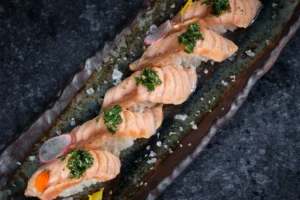Unveiling the Origins of Sushi: A Journey Through Time and Fermentation
Sushi, the ubiquitous symbol of Japanese cuisine, is more than just a delicious combination of rice and seafood. It’s a journey through time, a testament to human ingenuity, and a story deeply rooted in the cultural fabric of Japan. Today, we embark on a voyage to uncover the origins of this beloved dish, tracing its path from ancient preservation techniques to modern culinary artistry.
Fermented Beginnings: From Narezushi to Modern Sushi
The story of sushi doesn’t begin with pristine sashimi or vibrantly coloured rolls. It starts much earlier, around the 2nd century BC in Southeast Asia, where a dish called “narezushi” emerged. This was a fermented concoction of rice and fish, a method used to preserve food in the absence of refrigeration. The rice, inoculated with naturally occurring bacteria, fermented over several months, breaking down the fish and creating a pungent, savoury dish. While the rice was often discarded, the fermented fish was consumed, providing a vital source of protein during lean times.
The Journey to Japan: Adapting and Evolving
Narezushi made its way to Japan around the 8th century, likely through trade routes. Here, it underwent several transformations. The Japanese, with their unique cultural preferences, found the fermented rice unpalatable. They began experimenting with shorter fermentation times, resulting in a milder-flavoured “namanare sushi” (“raw-fermented sushi”). This innovation, while still relying on fermentation for preservation, marked a significant shift towards the sushi we know today.
Edo Period: The Birth of Modern Sushi
The Edo period (1603-1868) witnessed a pivotal transformation in sushi’s history. The bustling urban centre of Edo (modern-day Tokyo) demanded faster food options. Enter Hanaya Yohei, a street vendor credited with inventing “nigiri-zushi” in the early 19th century. This consisted of hand-pressed vinegared rice topped with slices of fresh fish, a format that revolutionised sushi consumption. Vinegar replaced fermentation for preservation, offering a quicker and more palatable option.
The Rise of Nigiri-zushi and Beyond
Nigiri-zushi’s popularity soared, becoming the go-to fast food for Edo’s working class. The focus shifted towards fresh, high-quality seafood, meticulously prepared and presented. This laid the foundation for the modern sushi experience, emphasising freshness, precision, and artistry.
Evolution and Global Expansion:
The 20th century saw sushi’s further evolution. New variations like “chirashizushi” (scattered sushi) and “uramaki” (inside-out rolls) emerged, showcasing the creativity and adaptability of sushi chefs. World War II and subsequent globalisation led to the introduction of sushi to Western cultures. Initially met with scepticism, sushi gradually gained popularity, captivating palates with its unique flavours and textures.
Beyond the Plate: Cultural Significance and Sustainability
Sushi is more than just food; it’s deeply intertwined with Japanese culture. The emphasis on fresh, seasonal ingredients reflects a respect for nature. The meticulous preparation and presentation embody the values of precision and dedication. The communal act of sharing sushi fosters connection and social interaction.
However, the growing global demand for sushi raises concerns about sustainability. Overfishing and unsustainable aquaculture practices threaten the delicate balance of marine ecosystems. Responsible sourcing and mindful consumption are crucial to ensure the future of this cultural treasure.
Conclusion: A Legacy of Innovation and Cultural Significance
From its humble beginnings as a fermented preservation technique to its modern incarnation as a global culinary phenomenon, sushi’s journey is a testament to human ingenuity and cultural adaptation. As we savour each bite, we not only indulge in delicious flavours but also connect with a rich history and appreciate the artistry and cultural significance this unique dish embodies. Let us continue to enjoy sushi responsibly, ensuring its legacy as a sustainable and cherished part of our culinary world.


